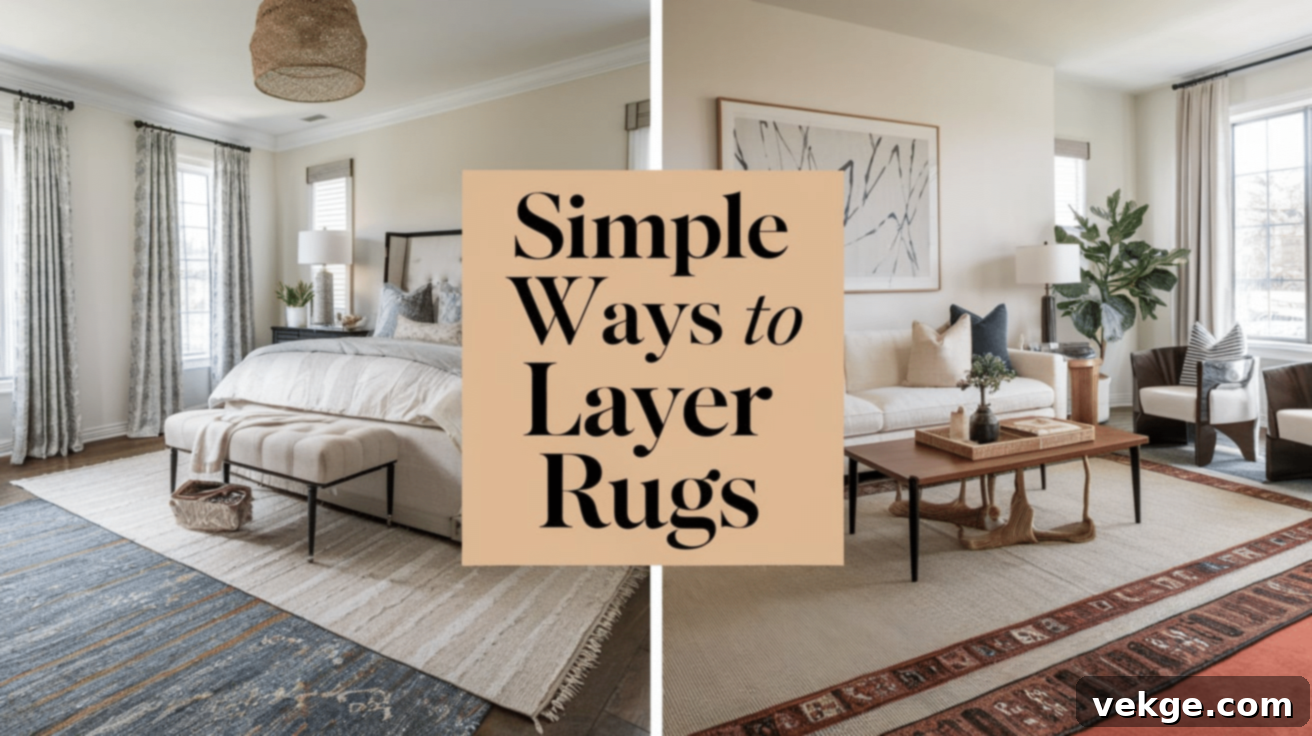Master the Art of Layered Rugs: A Comprehensive Guide to Cozy, Stylish Home Decor
Layering rugs is a beloved interior design technique that instantly injects warmth, depth, and character into any living space. Far more than just a functional floor covering, a thoughtfully layered rug arrangement creates a rich, inviting atmosphere, making your home feel uniquely yours. This approach involves strategically placing two or more rugs on top of each other, typically starting with a larger base rug and accenting it with smaller, complementary pieces.
This versatile trend offers an exciting opportunity to experiment with textures, colors, and patterns, allowing you to define different zones in an open-concept layout or simply add a touch of luxurious comfort to a single room. Whether you’re aiming for a minimalist look, a bohemian vibe, or classic elegance, layering rugs can elevate your decor significantly.
In this comprehensive guide, we’ll dive deep into the world of layered rugs. We’ll explore the compelling reasons to embrace this style, provide expert tips on selecting the perfect rugs, offer inspiring design ideas, and walk you through the process of arranging them like a seasoned professional. Get ready to transform your floors and infuse your home with unparalleled charm and coziness!
Why Embrace the Layered Rug Look in Your Home?
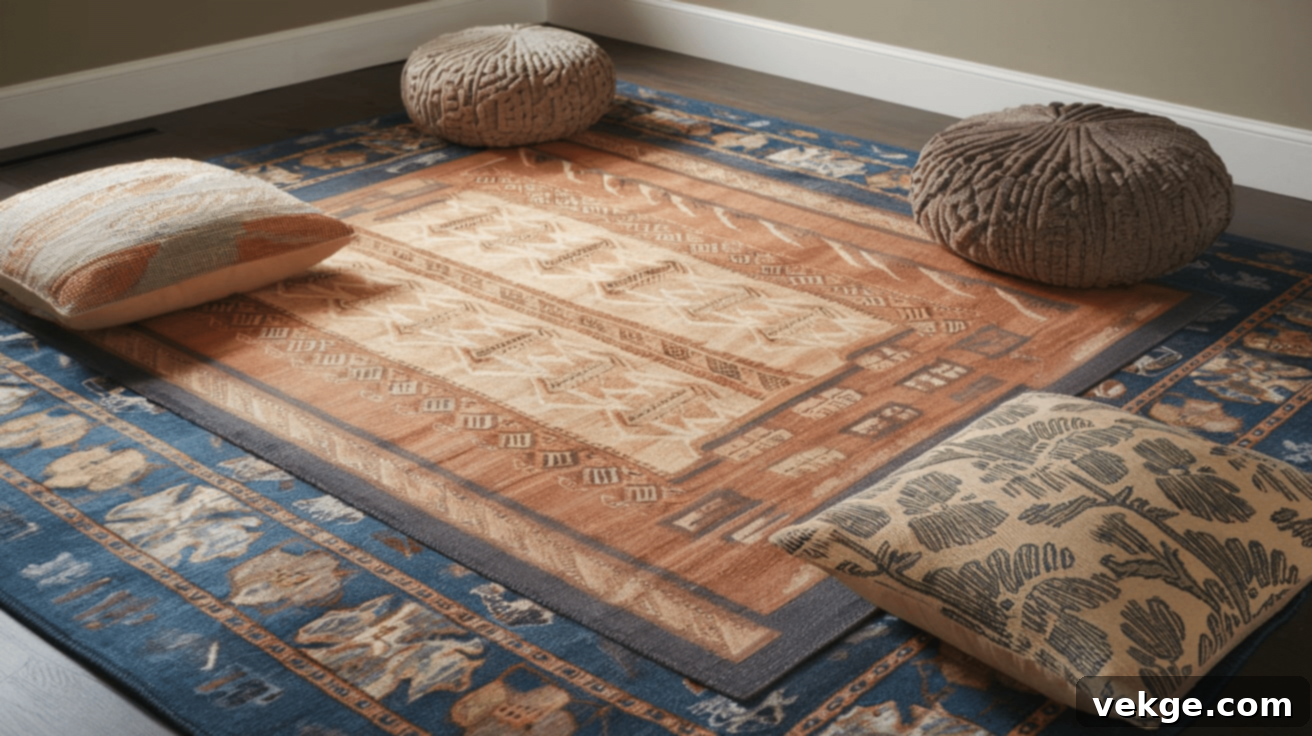
The appeal of layering rugs goes beyond mere aesthetics. This design strategy offers a multitude of benefits that can enhance both the functionality and beauty of your home. Here’s why layering rugs is a trend worth adopting:
1. Instant Warmth and Unmatched Comfort
One of the most immediate benefits of layering rugs is the profound sense of warmth and comfort it brings. Adding an extra layer of soft textiles underfoot makes any room feel more welcoming and cozy, particularly during colder months. It transforms hard floors into a plush, inviting surface, perfect for relaxing or creating a snug play area for children.
2. Creates Depth, Texture, and Visual Interest
Layering is an excellent way to introduce dynamic texture and visual depth to your space. By combining rugs of different materials – think a coarse jute base with a soft wool top, or a flat-weave beneath a shaggy sheepskin – you create a multi-dimensional effect that catches the eye. This interplay of textures makes the room feel more sophisticated and thoughtfully designed, moving beyond a flat, one-dimensional look.
3. Defines Areas in Open-Concept Living Spaces
In open-plan homes or large rooms, defining distinct zones can be a challenge. Layered rugs offer a stylish and practical solution. A large base rug can anchor an entire seating arrangement, while a smaller, contrasting rug can then define a cozy conversation nook, a reading corner, or separate the living area from a dining space. This technique helps organize the room visually without the need for physical dividers.
4. Infuses Style and Personal Personality
Layering rugs is an incredible opportunity to showcase your unique personal style and inject personality into your decor. It’s a chance to experiment freely with different colors, patterns, and even eras. Mix a vintage Persian rug with a modern geometric design, or pair a vibrant abstract piece with a subtle neutral. This creative freedom allows you to craft a space that truly reflects your aesthetic and makes a bold statement.
5. Enhances Acoustic Comfort
Beyond visual and tactile benefits, rugs also play a crucial role in sound absorption. Layering multiple rugs significantly improves a room’s acoustics by dampening echoes and reducing ambient noise. This creates a quieter, more serene environment, making conversations clearer and enhancing overall comfort.
In essence, the layered rug look is an accessible yet powerful design tool to make your home feel more inviting, stylish, and full of character. It’s a simple way to elevate your interior design without a major renovation.
Choosing and Arranging the Right Rugs for Perfect Layering
Achieving a cohesive and stylish layered rug look starts with careful selection and thoughtful arrangement. It’s not just about stacking rugs; it’s about creating harmony and balance. Here are essential tips for choosing and positioning your rugs:
1. Select Your Foundation: The Base Rug
The base rug is the anchor of your layered setup – it’s the largest rug and establishes the overall footprint of your arrangement. This rug should be substantial enough to define the space and ground your furniture. For a living room, it should ideally extend under the front legs of your sofa and chairs. In a bedroom, it typically sits under the bed, extending outwards on three sides. Choose a base rug that complements the room’s overall color palette, often in a neutral tone or a subtle pattern, as it sets the stage for the rugs to come.
2. Introduce the Top Layer: Smaller Accent Rugs
The smaller rugs you layer on top are your statement pieces. These should complement, rather than perfectly match, the base rug. The key is to ensure the top rug is significantly smaller than the base, allowing a generous border of the base rug to show around its edges. This visual contrast in size is crucial for creating depth and preventing the space from looking cluttered. A good rule of thumb is for the top rug to cover about two-thirds to three-quarters of the base rug in the focal area.
3. Embrace the Power of Mixed Textures
One of the most impactful aspects of rug layering is the opportunity to combine diverse textures. This is where your room truly comes alive with sensory richness. Consider pairing a flat-weave jute or sisal rug as your base with a plush, high-pile wool or shaggy rug on top. Alternatively, a smooth cotton rug can be beautifully accented by a chunky knit or faux fur. The contrast in textures adds immense depth and makes the space feel more interesting and luxurious. Just ensure the textures feel balanced and don’t visually compete too aggressively.
4. Master Color and Pattern Coordination
When mixing colors and patterns, the goal is harmony, not chaos. If your base rug features a bold or intricate pattern, opt for a smaller top rug with a simpler design or a solid color picked from the base rug’s palette. If you wish to layer two patterned rugs, ensure they share a common color scheme or have patterns of different scales (e.g., a large-scale geometric base with a small-scale abstract top) to maintain balance and visual coherence. Monochromatic layering, where different shades of the same color are used, is also a sophisticated approach.
5. Align with Your Room’s Existing Style
Your layered rug choices should always align with the overarching aesthetic of your room. For a modern, minimalist space, opt for clean lines, subtle textures, and a limited color palette. If your home leans rustic or bohemian, natural fibers like jute, sisal, and wool in earthy tones or ethnic patterns will feel right at home. Ensure your rug selections feel like a natural extension of your existing decor, contributing to a cohesive and inviting atmosphere.
6. Strategic Placement and Alignment
Once you’ve selected your rugs, strategic placement is key. Typically, the smaller rug is centered on the base rug in the primary seating or focal area. However, don’t shy away from experimenting with off-center placement for a more dynamic, artistic look. For example, a smaller rug can be placed diagonally across a corner of the base rug to highlight a specific piece of furniture or create an unexpected visual element. Always use rug pads beneath both rugs to prevent slipping and keep them neatly aligned, ensuring a polished, professional finish.
By thoughtfully applying these principles, you can confidently choose and arrange rugs to create a layered look that adds significant style, warmth, and personality to your home. Don’t be afraid to experiment; sometimes the most unexpected combinations yield the most stunning results!
Inspiring Ideas for Your Layered Rug Look
Layering rugs offers endless creative possibilities, allowing you to tailor the look to your personal style and the specific needs of each room. Here are some inspiring ideas to spark your imagination and help you achieve the perfect layered rug aesthetic in your home:
1. Classic Neutral Layers for Serene Spaces
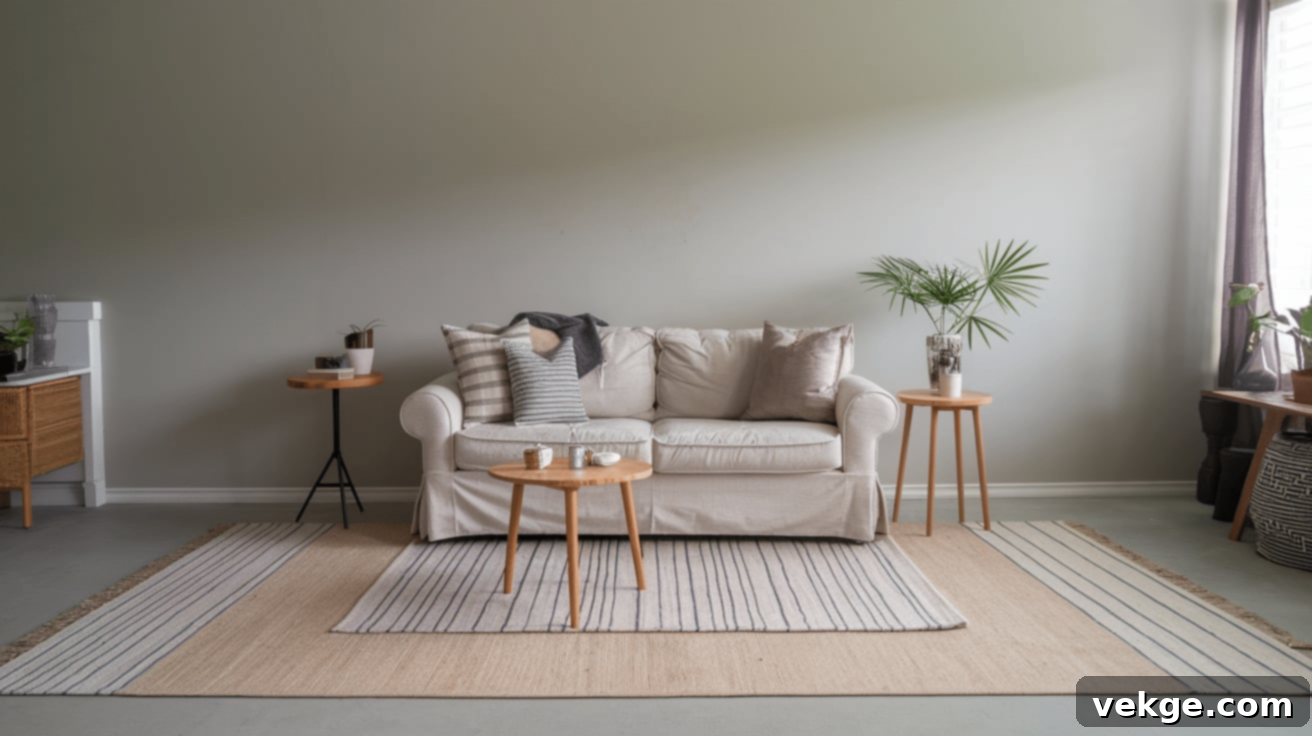
For those who appreciate understated elegance and a calm ambiance, classic neutral layering is an ideal choice. Begin with a large base rug in a soft, muted tone like cream, beige, light gray, or a subtle natural jute. On top, layer a smaller rug with a delicate texture or a very subtle pattern, such as thin stripes, a soft geometric motif, or even a different shade of the same neutral. This approach creates a sophisticated, inviting feel without overwhelming the senses, perfect for living rooms, bedrooms, or minimalist dining areas. It emphasizes texture and varying shades rather than bold contrast.
2. Playful Patterns for Dynamic Interiors
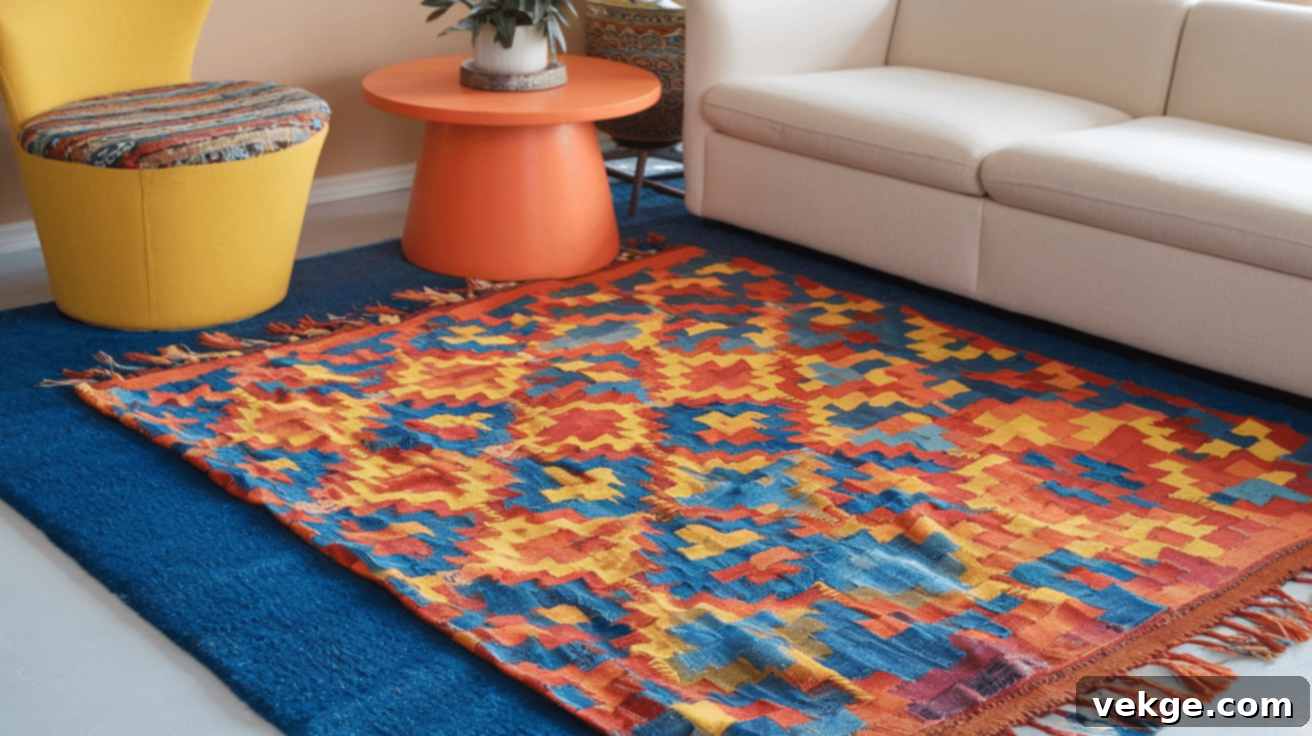
Dare to be bold by mixing and matching rugs with distinct patterns. This approach can inject energy and a vibrant personality into your space. A popular technique is to use a solid-colored or subtly textured rug as your base, then introduce a richly patterned rug on top – think a Moroccan Beni Ourain, a vintage Kilimin, or a graphic contemporary design. The trick is to ensure the patterns share a common underlying color scheme or have complementary tones to maintain visual harmony. This playful yet balanced mix creates an eye-catching focal point that feels both cohesive and exciting.
3. Creating a Cozy Oasis in the Bedroom
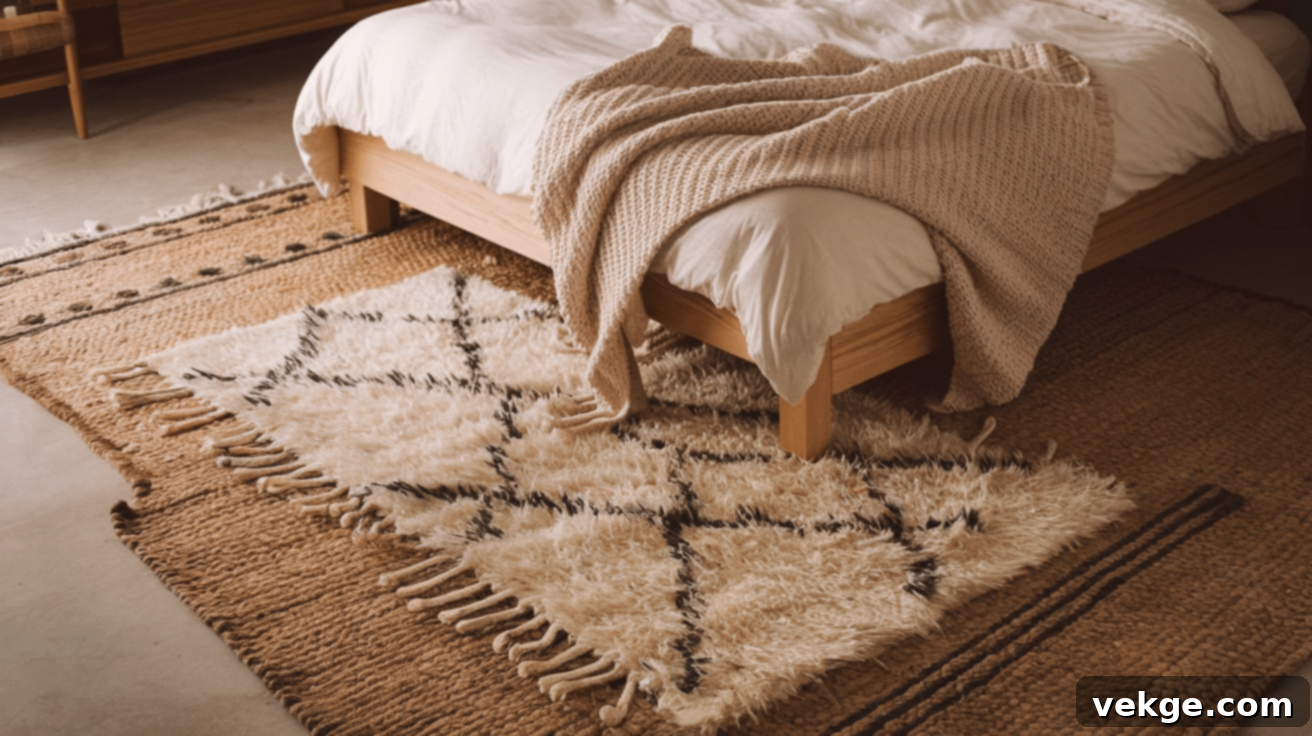
Layering rugs in the bedroom is a fantastic way to enhance comfort and create a truly luxurious, inviting sanctuary. Start with a large, soft rug that extends well beyond the sides and foot of your bed. This grounds the entire sleeping area. Then, add a smaller, perhaps shaggier or high-pile rug, either at the foot of the bed, under a bench, or positioned off-center beside one side of the bed. This instantly adds extra texture and warmth, making those first steps out of bed delightfully soft. It’s perfect for adding a touch of pampering to your private retreat.
4. Natural Textures for an Earthy, Organic Vibe

Embrace the beauty of nature by combining rugs made from organic materials like jute, sisal, wool, or cotton. A large, durable jute or sisal rug makes an excellent base, providing a foundation of earthy texture. Layer a smaller, softer wool or cotton rug on top, perhaps in a subtle stripe or solid neutral, to add a contrasting plushness. This creates a relaxed, organic, and effortlessly chic look that’s ideal for rustic, farmhouse, or bohemian-inspired interiors. The varying natural hues and textures bring an authentic, grounded feel to any room.
5. Bold Color Statements with Layered Hues
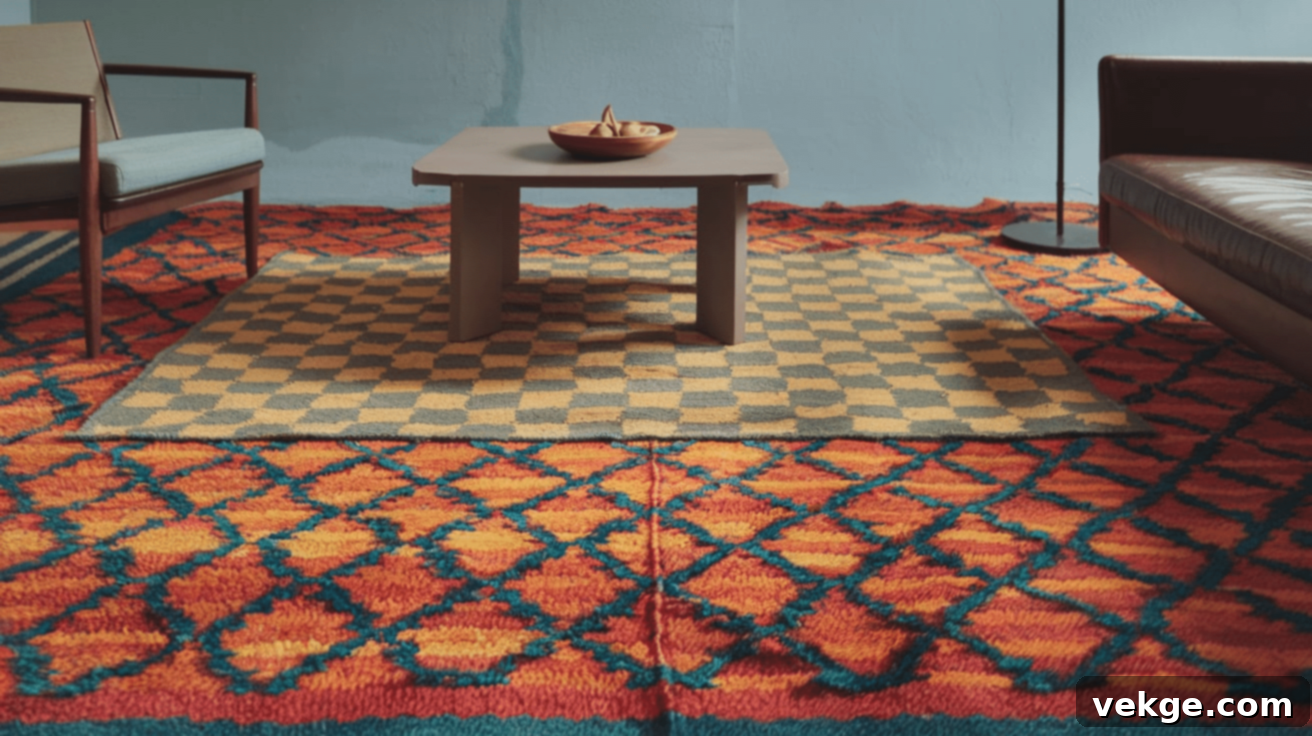
For the adventurous decorator, layering rugs in vibrant, bold colors can create an unforgettable statement. Choose a richly colored, patterned rug as your base – perhaps a jewel-toned Persian or an abstract modern piece. Then, layer a smaller, more muted rug on top, selecting a complementary or contrasting solid color to balance the intensity. Alternatively, layer rugs in analogous colors (e.g., shades of blue and green) for a harmonious yet dynamic effect, or use complementary colors (like blue and orange) for a high-impact visual pop. This technique transforms your floor into a captivating work of art.
6. Using Rugs to Master Space Definition
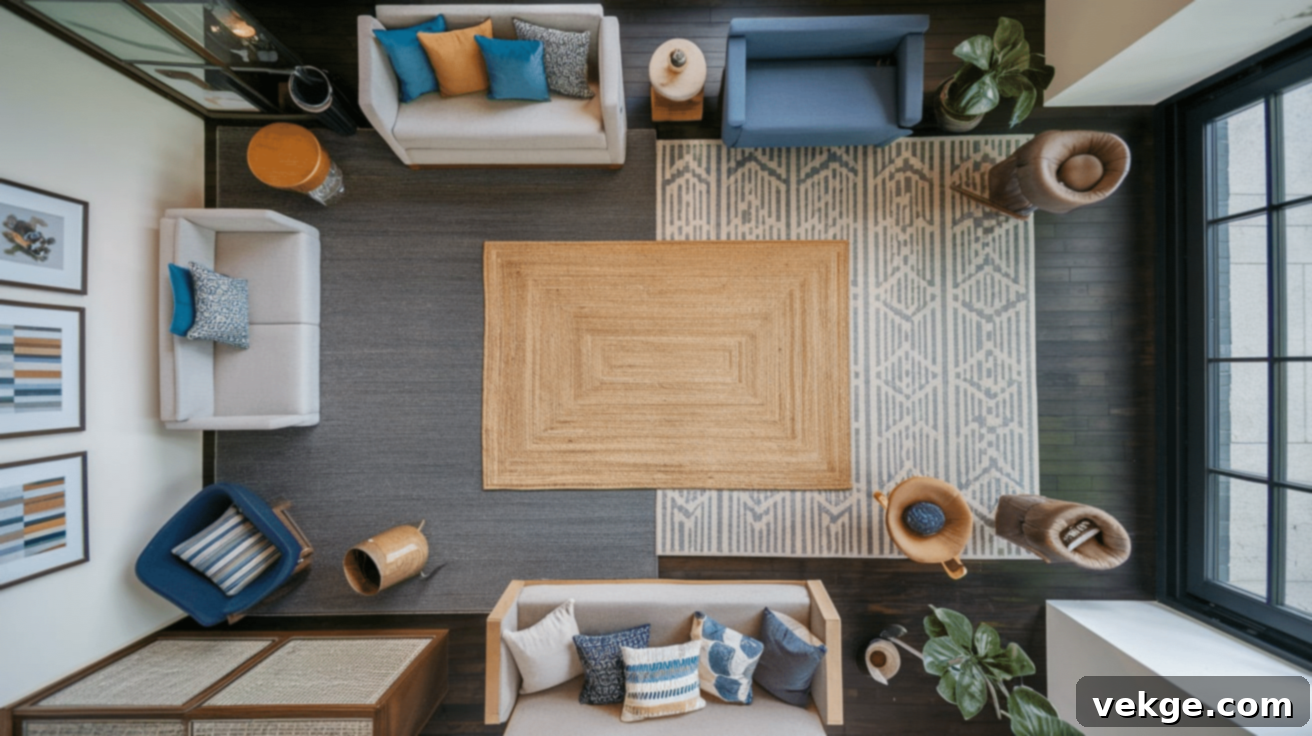
In larger rooms or open-concept floor plans, layered rugs are an ingenious tool for creating distinct functional zones without structural changes. Use a very large rug to encompass an entire area, such as a living room. Then, within that larger space, layer a smaller rug to define a specific nook – perhaps a cozy reading corner with an armchair, or a dedicated workspace with a small desk. This strategy helps to visually break up expansive areas, making them feel more intimate and organized while maintaining an overall cohesive design flow.
7. Layering Strategically Under Furniture

To add an extra layer of depth and sophistication, consider extending your layered rug arrangement partially under key pieces of furniture. Start with a substantial base rug that anchors your main seating arrangement. Then, place a smaller accent rug underneath a coffee table, a console table, or even the front portion of an armchair. This creates a more integrated and intentional look, making the rugs feel like a natural extension of your furniture arrangement rather than separate elements. It’s particularly effective in living rooms and dining areas for a polished finish.
8. Curating a Vintage-Inspired Ambiance
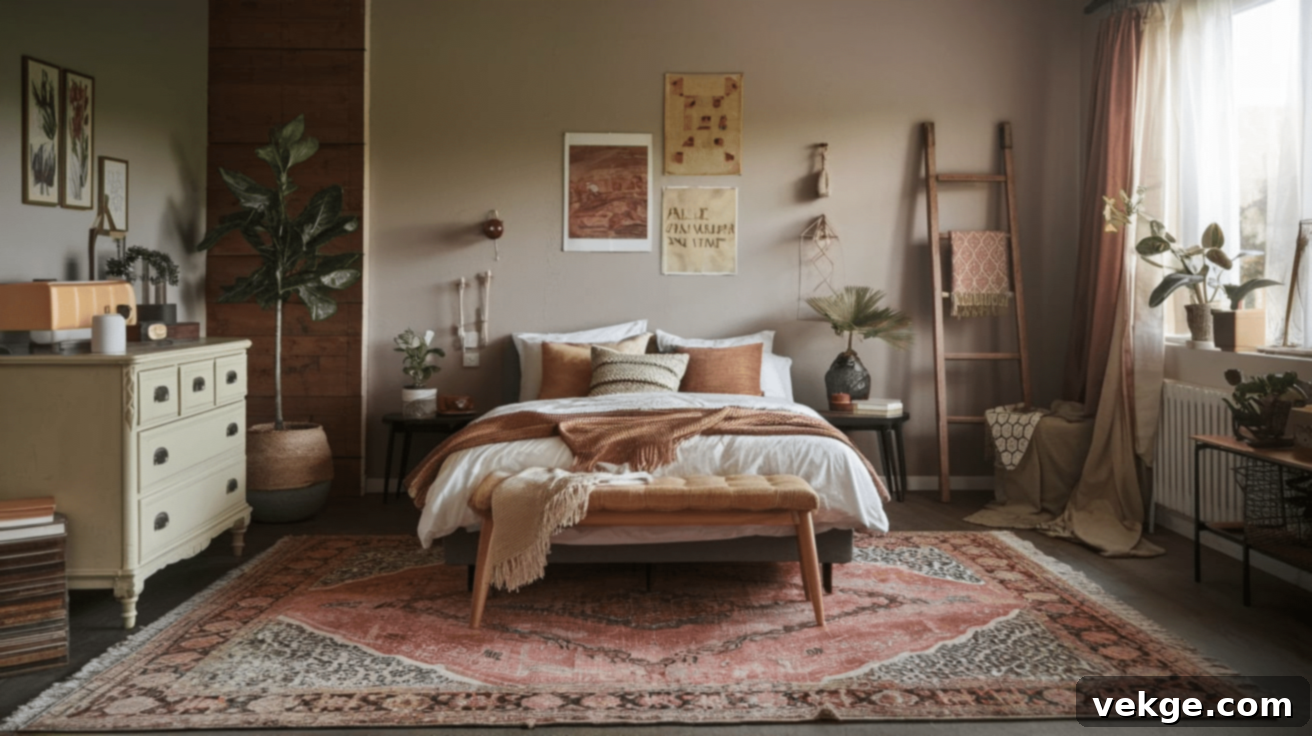
For a rich, storied aesthetic, combine contemporary rugs with pieces that evoke a vintage charm. Layer a modern, clean-lined area rug as your base, then introduce a smaller, antique-style Persian or Turkish rug on top. Look for rugs with faded patterns, a distressed look, or rich, muted jewel tones to achieve this effect. This fusion of old and new adds a nostalgic yet incredibly stylish vibe, creating a space that feels collected, warm, and full of history. It’s an excellent way to add unique character and depth.
The beauty of layering rugs lies in its flexibility. Don’t hesitate to mix and match these ideas or come up with your own unique combinations. The ultimate goal is to create a space that feels comfortable, inviting, and truly reflective of your personal style. Have fun experimenting and watching your rooms transform!
Where to Master the Layered Rug Look in Your Home
The versatility of layered rugs means they can be incorporated into almost any room, instantly elevating the space with added style, comfort, and warmth. Here’s a guide to the best spots in your home for embracing this popular design trend:
1. The Living Room: The Ultimate Canvas
The living room is arguably the most popular and ideal space for experimenting with layered rugs. Start with a large area rug that grounds the entire seating arrangement, ensuring it extends under the front legs of your sofa and armchairs. Then, introduce a smaller, often contrasting, rug centered under the coffee table. This not only defines the primary conversation area but also adds immense texture and a luxurious feel, making the heart of your home exceptionally cozy and stylish.
2. The Bedroom: A Haven of Comfort
Transform your bedroom into an extra-cozy sanctuary with layered rugs. A large base rug should span beneath the bed, extending out on all sides where you step down. On top, place a smaller, softer rug – perhaps a sheepskin or a shaggy wool piece – at the foot of the bed, or strategically beside your nightstand. This adds a delightful plushness underfoot, enhances warmth, and creates a layered, opulent look that promotes relaxation and comfort.
3. The Entryway: A Welcoming First Impression
Your entryway is the first impression guests have of your home, and layered rugs can make it truly welcoming. Use a larger, durable rug or a long runner that fits the entire entry space as your base. On top, layer a smaller, perhaps more decorative or patterned rug to greet visitors. Beyond aesthetics, this technique is practical, as the layered rugs help to trap dirt and moisture, keeping the rest of your home cleaner.
4. The Dining Room: Defining the Feast
In an open-concept living space, layering rugs in the dining room is an excellent way to subtly define the dining area. Choose a large, flat-weave base rug that comfortably accommodates your dining table and chairs, allowing chairs to remain on the rug even when pulled out. Then, for added visual interest or a pop of color, center a smaller, often patterned rug on top, directly under the table. This creates a distinct zone for meals while adding warmth and style.
5. The Kitchen: Functional Style
While less common, layering rugs in the kitchen can add unexpected comfort and personality. In front of the sink or under a kitchen island, layer a long, narrow runner as your base. On top, add a smaller, perhaps more absorbent or decorative mat. This provides ergonomic comfort for standing, protects floors, and infuses a touch of cozy style into a highly functional space. Ensure rugs are easy to clean and ideally non-slip.
6. Hallways: Extending Warmth and Interest
Hallways can often feel neglected and purely transitional. Layering rugs is a brilliant way to bring life and warmth to these narrow passages. Use a longer runner as your base rug, extending through the majority of the hallway. Then, place a shorter, contrasting or patterned runner on top in a key area, such as near an entryway console or a gallery wall. This breaks up the visual length, adds texture, and creates a more inviting flow through your home.
7. The Home Office: Inspiring Productivity
Make your home office a more comfortable and inspiring place with layered rugs. A large rug beneath your desk and office chair can protect your flooring and reduce noise. Layer a smaller, softer rug in front of your chair or in a separate seating area within the office to create a balanced, cozy, and aesthetically pleasing workspace. This helps to make a functional room feel more inviting and less sterile.
8. Outdoor Spaces: Patio and Porch Comfort
Don’t limit the layered rug trend to indoors! On a covered patio, porch, or deck, layering outdoor-friendly rugs can transform a simple seating area into an extension of your indoor living space. Choose a large, weather-resistant base rug, then layer a smaller, patterned, or textured outdoor rug on top. This instantly adds color, warmth, and a resort-like feel to your outdoor entertaining zones. Always ensure your chosen rugs are specifically designed for outdoor use to withstand the elements.
From high-traffic living areas to intimate bedrooms and even outdoor escapes, the layered rug look is incredibly adaptable. It’s an effortless yet impactful way to inject personality, enhance comfort, and add sophisticated texture to virtually any room in your home.
Common Layering Mistakes to Avoid for a Polished Look
While rug layering is a fantastic way to elevate your home decor, it’s easy to fall into common traps that can detract from the desired effect. Avoiding these pitfalls will ensure your layered rug arrangement looks professional, balanced, and stylish:
1. Overcrowding with Too Many Rugs
One of the most frequent mistakes is using too many rugs. The goal is depth and texture, not clutter. Stick to a simple formula: one large base rug and one or, at most, two smaller accent rugs. Piling on too many rugs can make the space feel busy, messy, and visually overwhelming, diminishing the impact of each individual piece.
2. Clashing Patterns and Textures
While mixing patterns and textures is encouraged, clashing is a definite no-go. Two overly busy or competing patterns without a unifying element (like a shared color or complementary scale) will create visual dissonance. Similarly, textures that are too similar or too jarringly different can fail to create harmony. Ensure patterns complement each other, and textures offer a pleasing contrast without fighting for attention.
3. Mismatched or Unharmonious Colors
Color coordination is crucial. Avoid layering rugs with colors that severely clash or create an unpleasant visual contrast. While bold color statements are welcome, ensure the chosen hues either complement each other, belong to the same color family, or are balanced by neutrals. A jarring color combination can make the room feel disconnected and uncomfortable.
4. Poor Rug Placement and Alignment
Sloppy placement can instantly undermine the elegance of layered rugs. Ensure your rugs are properly aligned and centered (unless intentionally off-center for a specific artistic effect). Uneven edges, crooked rugs, or a smaller rug that looks randomly thrown down can make the entire arrangement appear unbalanced and untidy. Use rug pads to prevent slipping and maintain precise positioning.
5. Using an Incorrectly Sized Top Rug
The size relationship between your base and top rug is paramount. A smaller rug that is too tiny will look insignificant and out of place, almost like a bathmat. Conversely, a top rug that is too large will obscure too much of the base rug, defeating the purpose of layering and potentially making the space feel cramped. Aim for a top rug that reveals a substantial border of the base rug, typically covering about 60-75% of the visible base area in the layered zone.
6. Neglecting Rug Pads
Ignoring rug pads is a common safety and aesthetic oversight. Rug pads prevent rugs from slipping, which is vital for safety, especially with layered rugs. They also provide extra cushioning, absorb sound, and help keep your rugs in place, preventing them from bunching, curling, and looking disheveled. Always use a high-quality rug pad for both your base and top rugs.
By being mindful of these common mistakes, you can master the art of layered rugs and create a polished, inviting, and truly harmonious look in your home.
Conclusion
Layering rugs is a simple yet profoundly impactful design technique that can completely revitalize any room in your home. It’s an accessible way to introduce instant warmth, luxurious texture, and a personalized touch that makes a space truly inviting and unique. From defining distinct zones in an open-plan layout to simply adding a deeper layer of comfort underfoot, the benefits are both aesthetic and functional.
The key to mastering this trend lies in thoughtful selection and arrangement. Remember to start with a substantial base rug to anchor your space, then carefully choose smaller accent rugs that complement in texture, color, and pattern without overwhelming. Embrace the creative freedom to mix materials, experiment with hues, and play with different scales to find a combination that resonates with your personal style and enhances your existing decor.
Don’t be afraid to experiment with placement, try various combinations, and even consider extending the layered look to unexpected areas like hallways or outdoor patios. By avoiding common pitfalls such as overcrowding or clashing designs, and always utilizing rug pads for stability, you’ll ensure your layered rug arrangement looks polished and professionally styled.
Ultimately, layering rugs is more than just a decor trend; it’s an opportunity to inject personality and soul into your living environment. So, get creative, have fun mixing and matching, and enjoy the transformative power that this versatile design approach brings to your home.
Frequently Asked Questions About Layering Rugs
Can I mix different patterns when layering rugs?
Absolutely, mixing patterns is a fantastic way to add visual interest, but it requires a careful approach. If your base rug has a bold, dominant pattern, it’s often best to select a smaller top rug with a simpler, more subtle design or even a solid color that picks up one of the hues from the base rug. If you want to combine two patterns, ensure they share a common color palette or have patterns of different scales (e.g., a large geometric base with a small floral top) to prevent them from clashing and creating a chaotic look. The goal is harmony and intentional contrast, not competition.
Where should I place my layered rugs for the best effect?
Layered rugs are most effective in areas that serve as focal points or benefit from added comfort and definition. Popular spots include: under a coffee table in the living room, extending from under the bed in a bedroom, to define a seating area, or in an entryway for a welcoming touch. They can also work wonders in a dining room to delineate the eating space or in hallways to add warmth. The key is to place the smaller, top rug in a high-traffic or visually important area, centered or strategically off-center on the larger base rug, to draw the eye and enhance the room’s design.
How can I make sure my layered rugs stay securely in place?
Keeping layered rugs from slipping and shifting is crucial for both safety and aesthetics. The most effective solution is to use high-quality non-slip rug pads underneath both rugs. A thicker pad under the base rug provides cushioning and stability, while a thinner, grippy pad under the top rug helps it adhere to the base rug. For extra security, especially for the top rug, you can use double-sided rug tape around the edges or corners to prevent curling and ensure it stays perfectly aligned. This helps maintain a tidy, professional appearance and prevents tripping hazards.
How many rugs should I layer for a stylish look?
For a balanced and stylish layered look, it’s generally best to stick to two rugs: one large base rug and one smaller accent rug on top. While occasionally three rugs can work in very large spaces with a clear design vision, adding too many rugs can quickly make a space feel overcrowded, cluttered, and visually overwhelming rather than cozy. The goal is to create depth and interest through a thoughtful combination, not to cover every inch of floor with multiple layers. Keep it simple and allow each rug to contribute to the overall aesthetic without competing.
What types of rugs are best for layering?
The best rugs for layering offer contrasting textures and complementary designs. For the base rug, durable, flat-weave options like jute, sisal, flat-weave wool, or a low-pile cotton rug are excellent choices as they provide a stable foundation. For the top accent rug, you can introduce more plush textures like high-pile wool, shaggy flokati, soft cotton, or even a faux fur rug. Patterned rugs like traditional Persians, Oushaks, Moroccan Beni Ourains, or Kilims also work wonderfully as top layers. The key is to choose rugs that offer a noticeable difference in texture, pile height, or visual interest to create that desirable layered effect.
